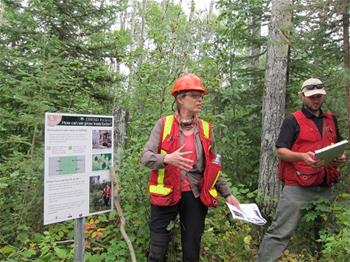Engaging Stakeholders
Canfor and Canfor Pulp work with a wide range of stakeholders. There is significant public involvement in the development of our Sustainable Forest Management Plans and we offer opportunities for public input into our forest management activities.
Our proprietary database, Creating Opportunities for Public Involvement (COPI), tracks communications, actions and issues with stakeholders and other interested parties. It provides both a record of stakeholder contact information and a repository for communications, and can be used to send out information and generate reports. The database includes spatial information that identifies areas of geographic interest and links to overlapping tenure holders such as guide outfitters, trappers and mineral tenure holders.
We rely on staff knowledge, Public Advisory Groups (PAGs) associated with our forest certification program commitments, newspaper advertisements, open houses and presentations to local government, associations or interest groups to develop our list of stakeholders. Staff in all locations meet with local and regional representatives and with other forest users so we can be sure their needs and concerns are considered when we are drawing up our management plans.
The 2016 FSC audit of our interior woodlands operations noted that Canfor provides opportunities for ongoing public participation, including an active public advisory committee, face-to-face meetings, emails, mail-outs and public forums. It pointed out that we mailed harvest notices to 89 stakeholders and First Nations between April and October 2016, and stakeholder interviews confirmed we were responsive to public concerns. The audit team described COPI as an extensive, transparent articulation of Canfor’s public participation process although they noted one instance where a solution to an issue was not recorded in the database. The audit noted that Canfor takes steps to resolve disagreements before they are elevated to grievances.
Since the 1990s, Canfor has been certified to the CSA Z809 standard, which is unique in that it has a specific requirement to engage the public through the use of PAGs. We participate in 11 PAGs across Western Canada. They represent a wide range of interests and come together to discuss current practices, review our sustainable forest management plans, and monitor key indicators.
In August, Canfor Grande Prairie’s Public Advisory Group and Daishowa-Marubeni International Ltd.’s Public Advisory Committee toured EMEND (Ecosystem Management Emulating Natural Disturbance), one of Canada’s most recognized boreal research projects. EMEND is dedicated to long-term forest research on 7,000 hectares northwest of Peace River, Alberta. Canfor and DMI have been supporters of EMEND since it began in 1999. Over the project’s lifespan, partners have contributed close to $18 million.
EMEND is a collaborative research program with the goal to study ecosystem response to different harvest and fire treatments. Individual research studies at EMEND look at the effect of varying harvest and retention patterns on mammals, forest structure, and other biodiversity characteristics. Our Public Advisory Groups were given an opportunity to walk through the interpretive trails at EMEND and discuss the research and key findings regarding boreal ecology with University of Alberta staff and research students, as well as Natural Resources Canada staff. It gave them insight into how the research that is being conducted at EMEND helps inform the development of sustainable forest management plans as well as help drive policy development within the Alberta.


Canfor's Ellen Macdonald (top) and Melonie Zaichkowsky leading various Public Advisory Group tours.
In June, we hosted a tour of our operating areas near Cranbrook, BC, for members of the Forest Practices Board, British Columbia’s independent forest watchdog, and a representative from Wildsight, a local environmental non-profit. Dave Clarke, executive director of the board, said members “were very impressed with the dedication and passion shown by Canfor staff, and had excellent discussions about the different challenges faced by Canfor.”
Canfor Pulp has been active in airshed management since we built our first mills in Prince George in the 1960s, and recently invested $180 million in three significant air quality improvements that are delivering measurable results. Forest research centre FPInnovations worked with Canfor to monitor the city’s air quality before and after the mill upgrades, and found a significant drop in the percentage of time odour is detectable.
Canfor Pulp once again participated in the World Wildlife Fund’s Environmental Paper Company Index 2017 to increase our transparency and better understand our opportunities for improving our sustainability performance.

Canfor conducted a field visit to a guide outfitter’s cabin in the Anzac operating area near Prince George to review any existing concerns regarding visuals from the guide camp and access. As a result of the review, sections of road leading to the cabin were improved and visual renderings completed. A future cut block with visual concerns had boundary changes to minimize views from the guide cabin after harvesting.